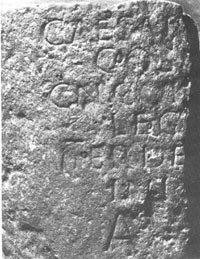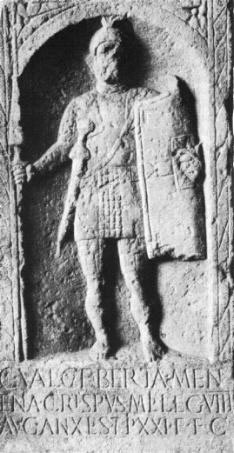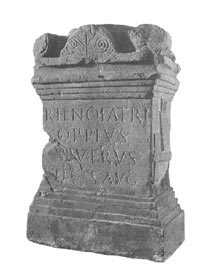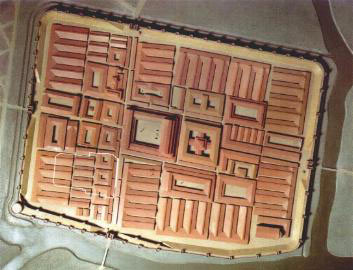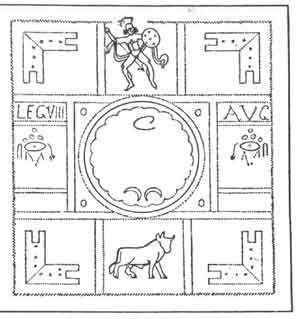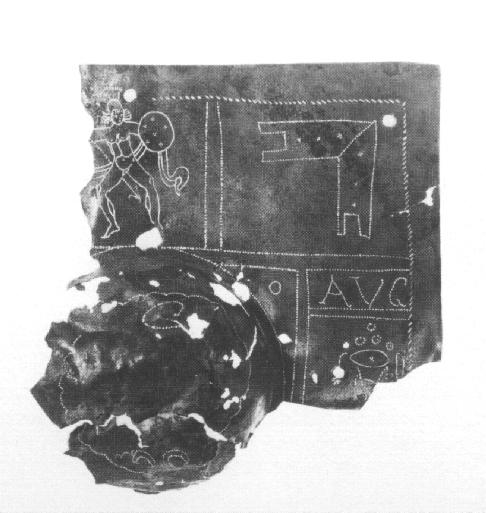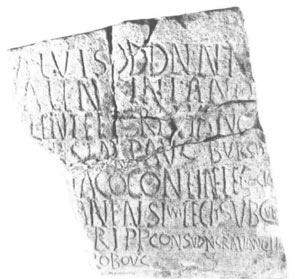 |
 |
|
|
|
|
|
|
|
|
|
The
legion |
|
|
|
|
|
|
|
|
|
|
|
|
The Historical LEGIO VIII AUGUSTA During the Civil war in the first century BC the 8 th legion was reactivated from veterans of Caesar` s Legio VIII by Octavianus ( later emperor Augustus). She got the honor title of "Augusta" . It is not sure, where the legion was stationed between 27 BC and 14 AD. Two inscriptions that were found in Tunesia may indicate the legion`s presence in Northern Africa during this time. In 14 AD the legion had her base in Pettau ( Poetivio in Pannonia). At the beginning of the first century AD the Legio VIII Augusta belonged to the Illyric-Moesian Army at the Balcans. It is possible that parts of the legion where involved in the invasion of Britain under Claudius in 42 AD, although there is no proof for this theory. Finally she was stationed in her headquarters in NOVAE (Bulgaria) from 44-
69 AD. The Civil war and the absence of large troops was used by the Batavians at the Lower Rhine to start up a revolt against Rome. After his victory in Italy, Vespasianus immediately sent his legions to Germany to strike down the revolt . After restoration of Rome`s rule in the North, LEGIO VIII AUGUSTA moved to her new headquarters in Argentorate (Strasbourg) in 70 AD, where the main part of the unit was stationed until the 5 th century when the Romans withdrawled. Some detachtments (vexillationes) of the legion were stationed in the camp of Mirbeau (Burgundy) in the second half of the first century to avoid riots in the hinterland of the frontier. In 74 AD LEGIO VIII AUGUSTA under the command of Pinarius Clemens built a
street through the Kinzig valley ( Black Forest ) to shorten the way from
Augusta Vindelicorum (Augsburg) in Raetia to Mogontiacum( Mainz) in Upper
Germany. This was the beginning of the occupation of South West Germany (
territory of the present federal state of Baden-Wuerttemberg). Military camps
were built to control the new connection between Rhine and Danube and civilian
settlements arose.These civilian settlements at former military posts still
existed after the military has moved to other places (like Rottweil, Hüfingen, Ladenburg
etc.)
Probably the LEGIO VIII AUGUSTA took part in Domitian`s campaigns against the Chatti in the Taunus Mountains in 83/84 AD and in 88/89 AD. The tombstone of C. Valerius Crispus , found in the city of Wiesbaden, may indicate this participance. Crispus seems to have died during these campaigns and was buried in Wiesbaden. It is not clear how the legion voted during the revolt of Saturninus in 89
AD, but Domitian did not rely on the Legio VIII , but brought the loyal Legio
VII from Spain to strike down the revolt.
For a long period the characteristics of LEGIO VIII AUGUSTA were mainly defensive. She hardly was involved in the several military campaigns of the Empire. Detachments of the legion were engaged with construction orders in the new territory of the Agri Decumates ( South-West Germany) , but also in Gaul and Dalmatia ( today Croatia). These units restored or built auxiliary forts at the frontier line, the Limes, in Germany ( Neckarburken, Oberscheidental, Miltenberg, Osterburken, Saalburg, Zugmantel etc.). Beside this, Legio VIII AUGUSTA was involved in civilian construction projects. She built the 28 km long aqueduct for the water supply of Argentorate, public baths in Gaul and Dalmatia ( 2 nd century in Asseria). Brickworks were run by the legion in Strasbourg-Koenigshoffen and in Rheinzabern. Tiles showing the signs of LEGIO VIII were found at a large number of Roman forts along the limes, but also at places in Lower Germany, Raetia ( Aalen) and Gaul and in civilian towns like Rottenburg am Neckar / Sumelocenna. The legion produced her own ceramics which was only in use in and around
the headquarters in Strasbourg (Argentorate).
The legion`s headquarters , the fortress of Argentorate was built by
LEGIO VIII, because the fortress of Legio II was destroyed or heavily damaged
during the battles in 69 AD. The older camp probably was only a construction of
earth and wood, the new legion`s headquarters was now built in stone . The
fortress was 530 meters x 375 meters , this is exactly the medivial town centre
of Strasbourg. The present Rue du Dome follows the Roman Via principalis and the
present Rue des Hellebardes follows the Roman via praetoria.
Small units from the LEGIO VIII AUGUSTA served as so-called beneficiarii at different posts. They had to control the traffic,customs, taking police tasks. After their 2 years service they usually dedicated altars to several gods, before they returned to the headquarters. In Osterburken (Baden-Wuerttemberg) such a sacred area was excavated and a large number of altars was found. Some of them were set up by members of the LEGIO VIII. In Heidelberg the beneficiarius consularis C. Vereius Clemens dedicated a
column and an altar to Jupiter . Clemens probybly hat a guard order at the
bridge over the Neckar river.
Under emperor Hadrian, detatchments of the legion were sent to England ( between 119 and 130 AD) , but not for a military campaigns. They had to support the construction of Hadrian`s Wall. 186-213 AD the legion had the title "pia fidelis constans commoda", which was given to her at respect for her loyality to emperor Commodus during the Maternus- revolt. After the death of Commodus she gave up this title. At the beginning of the 3 rd century the period of peace for the legion
was over. Sources report about fightings against " defectores et rebelles",
pobably the supporters of Clodius Albinus.
Many relicts of the LEGIO VIII AUGUSTA and her deputations where found in SW-Germany and show us, how the unit was involved in daily life and administration of the country. Source: http://www.legio8augusta.de |
||||||||||||||||||

